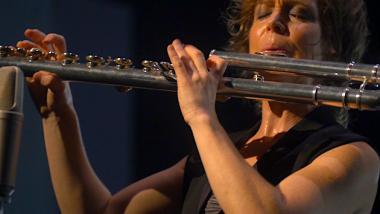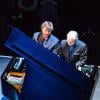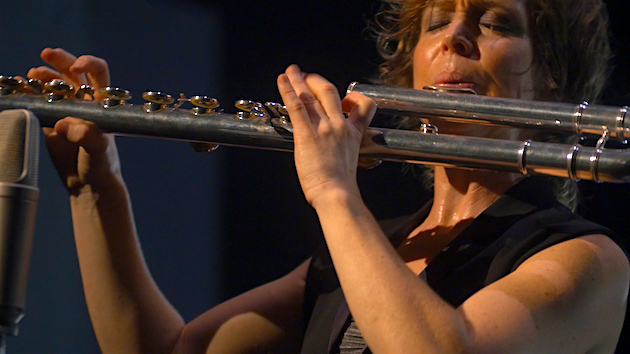
Had Goliath been a contrabass flute, a version of the flute that is so large and scarce as to seem a hoax, David might have needed backup. Faced with the challenge, the flutist Claire Chase, partway through her performance of “Density 2036: part vi,” merely snuggled beside it before beginning to play.
It was an intimacy with her instrument you would expect from a musician amidst a 23-year-long project to commission and premiere works for flute. The “Density 2036” series, honoring the centennial, in 2036, of Edgard Varèse’s landmark solo flute work Density 21.5, is Chase’s effort to forge the future of the flute. The project’s sixth installment, performed at The Kitchen last Friday, is continued proof that what Chase and her collaborators are up to exceeds even that ambition. Taking shape across the evening’s works was as much a vision of the flute as a vision of identity — a hybrid being where flute and self are inextricable.
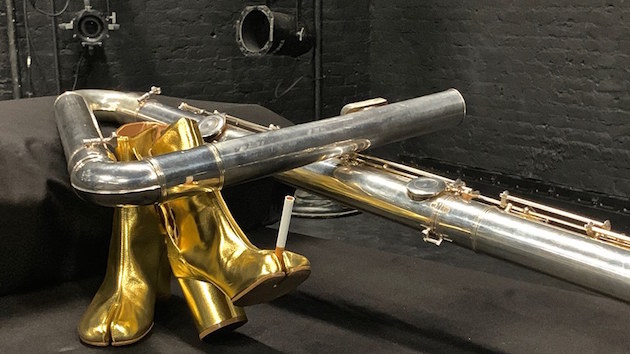
In a camouflage jumpsuit and gold heeled boots, like a drafted disco dancer, Chase commenced her program with Olga Neuwirth’s Magic Flu-idity, alongside percussionist Nathan Davis playing the typewriter. Originally for large ensemble, Neuwirth’s vision in duo form seemed to offer whimsical commentary on what it is like to be an artist at work: Davis hammering dutifully at the keys, Chase emitting a stream of virtuosic spits and pops — the sound, perhaps, of a writer’s exertions. Davis occasionally abandoned the keyboard for other toys, including a water glass whose rim he circled to produce a memorable halo around Chase’s phrases.
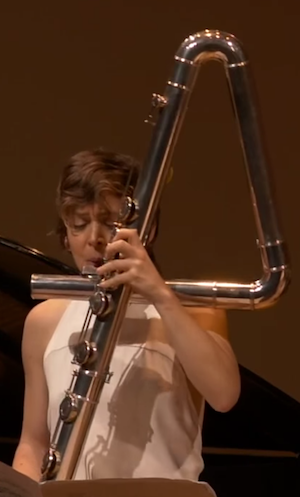
Pamela Z’s Louder, Warmer, Denser had Chase in dialogue with herself, in scrambled snippets of her own voice taken from her interview with the composer. Chase bounded about the stage — at one point lying down beside Bertha, the contrabass flute — playing in correspondence with her voice, finding a particularly apt match for her burbling laugh.
Thudding heartbeats introduced Roots of Interior, the composer and pianist Phyllis Chen’s reflection on her experience of having two heartbeats, her daughter’s and her own, during pregnancy. Alongside this ineluctable rhythm, Chase played faster and faster as though in pursuit of none other than herself — an inkling made concrete when the lights shifted to reveal her shadow on the back wall. Marisa Michelson, director of the vocal ensemble Constellation Chor, then climbed the stairs and held a stethoscope to Chase’s chest, allowing the flutist’s own heartbeat to accompany her last wisps of melody.
A breath between virtuosic displays, Sarah Hennies’s Reservoir 2: Intrusion found Chase in stasis, sitting cross-legged in the center of the stage and playing her flute at nearly inaudible volume. Michelson and eight other Chor singers circled her, humming low tones later spiked with grunts as if in an effort to speak. Occasionally, they stopped to pat each other down, like clumsy detectives. Chase seemed at best dimly aware that she shared the stage; the singers could have been excerpts from a dream. Inspired by the relationship between the conscious and unconscious, Hennies’s contribution was the evening’s centerpiece: an unnerving, extraordinary tableau of a mind feeling its way into the world.
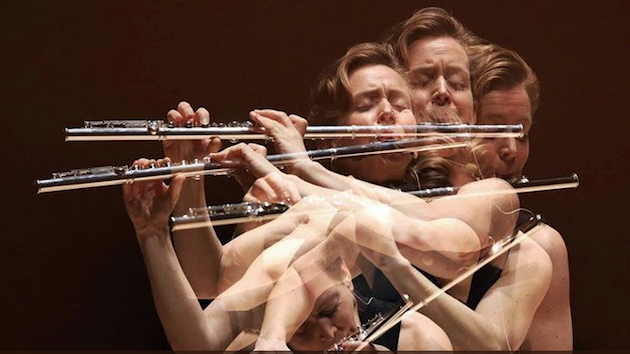
Purge, a short tape work by the Iranian composer Bahar Royaee sourced from previous Density performances, preceded Tyshawn Sorey’s Bertha’s Lair. With Sorey on drums, this was an explosive ode to timbre, which has appeared in other iterations on previous Density installments. At points, Sorey slashed the cymbal stand and coaxed sizzling textures from a gong, while Chase cycled through three flutes, including a whistle, which she yanked from her pocket as though there were any doubt that she was out of things to play.
Light Flute, a large tube of light that had been stirring all night in tandem with Chase’s playing — invented by Density’s sound designer and longtime Chase collaborator Levy Lorenzo — now drew the audience’s full attention. Chase then delivered Density 21.5, the light spreading across the tube to match the length and duration of her phrases. It seemed a kind of resonance, Chase’s luminous ideas made concrete. With all that had preceded it, one could easily imagine that Varèse’s revolutionary two-page score had been written for Chase, too.

